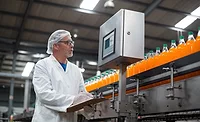Food Safety and Packaging: How to Keep Up With Consumer Concerns

The main function of packaging is to protect its contents. This may sound simple, but what does it really mean? Packaging has to look good with an appealing design for the consumer to make a purchasing decision. It also needs to be designed for proper converting and printing. But when it comes to food packaging, safety has to come first—meaning no harmful chemical, smell, or taste should transfer from packaging materials to the food.
Consumers worldwide are increasingly well-informed of the content of food and the amounts of chemicals they are exposed to. As more research data becomes available, there is steadily growing awareness and understanding of issues such as the chemicals contained in recycled fiber and its possible effect on humans.
Recycled fiber—particularly from materials collected from consumers—contains residues of printing ink, adhesives, lacquers, and other chemicals that should not come into direct contact with food and are known to be harmful to human health. One example of a potentially harmful chemical group in recycled pulp is the fluorinated substances used as grease barriers in paper packaging. Several fluorinated compounds are suspected of being carcinogenic, harmful to the immune system, and endocrine disrupters. Another rising cause for concern in recent years has been mineral oils, as harmful components of these have been found in foods that were packaged in materials made from recycled fiber.
When looking at paper and paperboard legislation globally, we see many regional differences. While most countries do not directly prohibit the use of recycled fiber, legislation and various country-specific recommendations do limit its use. Recycled fiber that is to be used as a food contact material must undergo a number of laboratory tests to ensure that the packaging material cannot release harmful substances into the product in amounts that would pose a risk to human health. If impurities or unwanted chemicals are a risk to consumer health, typically a barrier layer must be used to protect the food from contamination.
In the U.S. recycled paper can be used for food contact provided that it will not adulterate food in any way or pose a risk to human health. The U.S. Food and Drug Administration gives a set of guidance on the purity of the recycled pulp, and it must not contain poisonous or deleterious substances. Certain states also have their own legislation for food contact materials. In general, they need to be taken into account when using recycled fiber packaging for food.
There is no harmonized EU legislation on food contact materials for paper and board products. Food contact materials are covered by EU regulation that stipulates in general terms that materials that come into contact with foodstuffs must not enter the food in quantities that could endanger human health, cause unsuitable changes in the food composition, or impair its sensory properties. Being that this is the most specific level of legislation, the national laws and recommendations of the respective countries are applied.
For example, the use of recycled fiber for packaging that comes into direct contact with foodstuffs is forbidden in Switzerland, with some exceptions such as fruit that is peeled before eating. In Italy, the only product groups that can be packaged in such a way that they come into direct contact with recycled fiber packaging are product groups that are not subject to migration testing under the country’s legislation. (“Migration” in this context refers to the transfer of chemicals from packaging material to a product, or vice versa.) Among the products that are exempt from such testing are dry, fat-free foods.
Looking for quick answers on food safety topics?
Try Ask FSM, our new smart AI search tool.
Ask FSM →
In China, the use of recycled fiber is not directly prohibited by legislation, but legislation requires that paper and board materials that come into direct contact with foodstuffs need to pass certain laboratory tests. Materials that contain recycled fiber do not pass all of these tests.
The Key to Clean Packaging
“Clean packaging” is free from unknown chemicals and can be safely used in direct food contact. All the production chemicals and additives need to be approved for food contact, and the manufacturing needs to be certified and controlled. Materials need to be tested in external accredited laboratories to verify safety and compliance with regulations. Furthermore, they need to be carefully packaged to prevent contamination during transportation, and the same diligence needs to be followed for converting, packaging, and transport of ready goods. The product safety chain needs to be unbroken up to the time it reaches the consumer. When sourcing packaging materials, fresh fiber is the cleanest with traceable, naturally pure qualities.
Brands and packaging manufacturers should make sure their suppliers have a solid food safety process in place.
- Are all the raw materials—from wood to chemicals and additives—fully traceable and compliant with regulations?
- Does the production facility employ food safety management systems?
- Is the product compliant for intended end-use according to the regulations and recommendations in the planned marketing area (e.g. Europe, America or Asia?)
- Are the product’s organoleptic properties tested regularly during production?
The most important function of food packaging is to keep the contents and consumers safe. Everything else in the packaging world can be negotiated—price, delivery terms etc. But with safety, no compromises can be made. Product safety is non-negotiable.
Katja Tuomola, business development manager, Metsä Board, has over 18 years’ experience in the pulp and paper industry, and specializes in the formulation and application of chemicals for pulp and paper mills. Currently, she works with business development, but prior to that she was responsible for global product safety and food contact compliance of Metsä Board paperboard products.








